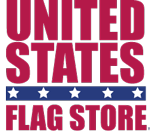 While South Carolina became the 8th state on May 23, 1788, a flag was not chosen until January 28, 1861. The flag is entirely blue with a white palmetto tree in the center while a white crescent is placed to the upper left hand corner. According to the official South Carolina website, the original version of the flag was designed by Colonel William Moultrie which consisted of only a white crescent on a blue field. Moultrie picked blue because it matched the uniforms his troops wore during the Revolutionary War while the crescent which resembled the silver emblem worn on their caps. Once the palmetto tree was added later on, it is explained that the tree represented Colonel Moultrie’s heroic defense of the palmetto log fort on Sullivan’s Island against the attack of the British fleet on June 28, 1776.
While South Carolina became the 8th state on May 23, 1788, a flag was not chosen until January 28, 1861. The flag is entirely blue with a white palmetto tree in the center while a white crescent is placed to the upper left hand corner. According to the official South Carolina website, the original version of the flag was designed by Colonel William Moultrie which consisted of only a white crescent on a blue field. Moultrie picked blue because it matched the uniforms his troops wore during the Revolutionary War while the crescent which resembled the silver emblem worn on their caps. Once the palmetto tree was added later on, it is explained that the tree represented Colonel Moultrie’s heroic defense of the palmetto log fort on Sullivan’s Island against the attack of the British fleet on June 28, 1776.
This flag also has a state pledge which was adopted by Act Number 910 of 1966 (approved April 22, 1966). Mrs. John Raymond Carson from Chester, SC, wrote the pledge for all South Carolinians: “I salute the flag of South Carolina and pledge to the Palmetto State love, loyalty, and faith.”
In South Carolina, tea is the official hospitality beverage of the state. This was designated to the state in 1995 after a bill was passed. South Carolina is the first state in the United States to grow tea. One of the most popular beverage s is the sweet tea, which is made by adding sugar to black tea while it is still hot, and is usually served iced.
s is the sweet tea, which is made by adding sugar to black tea while it is still hot, and is usually served iced.
How it got its name: South Carolina was named after King Charles I of England, the Latin version of his name being Carolus. He was the one who granted the land to Sir Robert Heath in 1629 in which to start his colony.
Popular places to go: Myrtle Beach, South Carolina. In the center of the Grand Strand, this coastal city gets over 14 million visitors every year. Beachgoers go swimming, walking on the boardwalk, and attend events.
~CD



